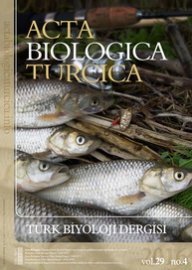Bio-ecology and commercial importance of solitary tube worms (Diopatra neapolitana Delle Chaije, 1841)
Abstract
Keywords
Full Text:
PDFReferences
Anonymous, (2019). Biorede, Diversidade Animal. http://www.biorede.pt/ (Date of access: 10 June 2019).
Arvanitides C, 2000. Polychaete fauna of the Aegean Sea: inventory and new information. Bulletin of Marine Science 66, 73–96.
Bailey-Brock J, 1984. Ecology of the tube-building polychaete Diopatra leuckart Kinberg, 1865 (Onuphidae) in Hawaii: community structure, and sediment stabilizing properties. Zoological Journal of the Linnean Society. 80, 191-199.
Blaise C, Gagné F, Gillis PL, Eullaffroy P, 2013. Polychaetes as bioindicators of water quality in the Saguenay Fjord (Quebec, Canada): a preliminary investigation. Journal of Xenobiotics, e1-e1.
Budaeva N, Fauchald K, 2008. Diopatra tuberculantennata, a new species of Onuphidae (Polychaeta) from Belize with a key to onuphids from the Caribbean Sea. Zootaxa 1795, 29–45.
Carregosa V, Velez C, Pires A, Soares AMVM, Figueira E, Freitas R, 2014. Physiological and biochemical responses of the Polychaete Diopatra neapolitana to organic matter enrichment. Aquatic Toxicology. 155, 32-42.
Choe S, 1960. On the life history of the Polychaeta Worm, Diopatra neapolitana Delle Chaije, Bulletin of the Japanese Society of the Scientific Fisheries, 26(4), 430-437.
Conti G, Massa F, 1998. Experienze de allavamento del polichaete Diopatra neapolitana Delle Chiaje, 1841 nella Laguna di S. Gilla (Sardegna Meridionale). Biologia Marina Meditteranea, 5, 1473-1480.
Cunha T, Hall A, Queiroga H, 2005. Estimation of the Diopatra neapolitana annual harvest resulting from digging activity in Canal de Mira, Ria de Aveiro. Fisheries Research, 76, 56–66.
Çınar ME, Dağlı E, Kurt-Şahin G, 2014. Checklist of Annelida from the coasts of Turkey. Turkish Journal of Zoology. 38: 734-764.
Dağlı E, 2017. Hatay Değirmen Dergisi. Boru Kurdu (Diopatra neapolitana Delle Chaije, 1841)’ nun Canlı Balık Avındaki Yeri ve Önemi. Değirmen Dergisi, Özel Sayı 2017, s.20-21, https://www.facebook.com/photo.php?fbid=10156285115314316&set=pcb.101562851245143&type=3&theater (Erişim tarihi: 03.07.2019).
Dağlı E, Ergen Z, Çınar ME, 2005. One-year observation on the population structure of Diopatra neapolitana Delle Chiaje (Polychaeta, Onuphidae) in Izmir Bay (Aegean Sea, Eastern Mediterranean). Marine Ecology 26, 265-272.
Dağlı E, 1999. İzmir Körfezinde Diopatra neapolitana Delle Chaije, 1841 (Polychaeta Annelida)’nın Populasyon Yoğunluğunun Saptanması, Ege Üniversitesi, Fen Bilimleri Enstitüsü, Yüksek Lisans Tezi S,71.
Dean HK, 2008. The use of polychaetes (Annelida) as indicator species of marine pollution: a review. Revista de Biología Tropical, 56(4), 11-38.
Erdem Ü, Başusta N, Türeli C, Duysak Ö, 2010. Su Omurgasızları (3. Baskı). Nobel Yayın Dağıtım No: 833, s. 191-201, Ankara-Türkiye.
Fauchald K, 1977. The Polychaete Worms Definitions and Keys to the Orders, Families and Genera. Natural History Museum Of Los Angeles County.
Fauchald K, Jumars PA, 1979. The diet of worms: a study of polychaete feding guilds. Oceanography and Marine Biology: An Annual Review, CRC Press.
Fauvel P, 1923. Faune de France, Polychètes errantes. In: Fédération Française des Sociétés de Sciences naturelles. Office central de Faunistique, Paris: 488 pp.
Freitas R, Pires A, Quintino V, Rodrigues AM, Figueira E, 2012. Subcellular partitioning of elements and availability for trophic transfer: comparison between the Bivalve Cerastoderma edule and the Polychaete Diopatra neapolitana. Estuarine, Coastal and Shelf Science. 99, 21-30.
Freitas R, Coelho D, Pires A, Soares AMVM, Figueira E, Nunes B, 2015. Preliminary evaluation of Diopatra neapolitana regenerative capacity as a biomarker for paracetamol exposure. Environmental Science and Pollution Research, 22(17), 13382-13392.
Gambi MC, Castelli A, Giangrande A, Lanera P, Prevedelli D, Zunarelli Vandini R. 1994. Polychaetes of commercial and applied interest in Italy: an overview. In: Dauvin J.C., Laubier L., Reish D. (Eds) Actes de la 4eme Conference internationale des Polychetes. Memoires du Museum National d’Histoire Naturelle de Paris, 162, 593 601.
Gambi MC, Giangrande A, 1986. Distribution of soft-bottom Polychaetes in two coastal areas of the Tyrrhenian Sea (Italy): structural analysis. Estuarine, Coastal and Shelf Science, 23, 847–862.
Hakkim VMA, 1975. Salinity tolerance of Diopatra neapolitana Delle Chaije: Annelida Polychaeta, Indian Journal of Marine Science, 4 (1): 99-101.
Lourido A, Cacabelos E, Troncoso JS, 2008. Patterns of distribution of the polychaete fauna in subtidal soft sediments of the Ría de Alda’n (Northwestern Spain). Journal of the Marine Biological Association of the United Kingdom 88, 263-275.
Moreira J, Quintás P, Troncoso JS, 2006. Spatial distribution of soft-bottom polychaete annelids in the Ensenada de Baiona (Ría de Vigo, Galicia, northwest Spain). Scientia Marina 70 (S3), 217–224.
Paxton H, 1986. Revision of the Rhamphobrachium complex (Polychaeta: Onuphidae). Records of the Australian Museum, 38(2), 75-104.
Paxton H, 1993. Diopatra Audouin and Milne Edwards (Polychaeta: Onuphidae) from Australia, with a discussion of developmental patterns in the genus. Beagle: Records of the Museums and Art Galleries of the Northern Territory, The, 10, 115.
Paxton H, 1998. The Diopatra chiliensis confusion – redescription of D. chiliensis (Polychaeta, Onuphidae) and implicated species. Zoologica scripta 27, 31–48.
Pires A, Gentil F, Quintino V, Rodrigues AM, 2011. Reproductive biology of Diopatra neapolitana (Annelida, Onuphidae), an exploited natural resource in Ria de Aveiro (Northwestern Portugal). Marine Ecology, 33(1), 56-65.
Rangel LF, Santos MJ, 2009. Diopatra neapolitana (Polychaeta: Onuphidae) as a second intermediate host of Gymnophallus choledochus (Digenea: Gymnophallidae) in the Aveiro Estuary (Portugal): distribution within the host and histopathology. Journal of Parasitology, 95, 1233-1236.
Rouse GW, Pleijel F, 2006. Reproductive biology and phylogeny of Annelida. Science Publishers.
Thomsen MS, Muth MF, McGlathery KJ, 2011. Tube-forming polychaetes enhance invertebrate diversity and abundance in sandy sediments of Mozambique, Africa. African Journal of Marine Science. 33(2), 327-332.
Rouse G, Pleijel F, 2001. Polychaetes. Oxford University press.
Thomsen MS, McGlathery K, 2005. Facilitation of macroalgae by the sedimentary tube forming polychaete Diopatra cuprea. Estuarine, Coastal and Shelf Science 62, 63- 73.
Weigert A, Bleidorn C, 2016. Current status of annelid phylogeny. Organisms Diversity& Evolution, 16(2), 345-362.
Wehe T, Fiege D, 2002. Annotated checklist of the polychaete species of the seas surrounding the Arabian Peninsula: Red Sea, Gulf of Aden, Arabian Sea, Gulf of Oman, Arabian Gulf. Fauna of Arabia, 19, 7–238.

